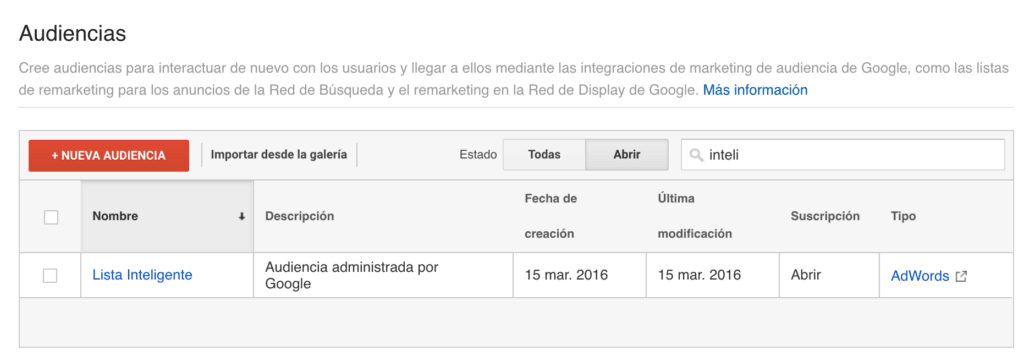Historias de Aprendizaje: Objetivos Inteligentes en AdWords
Hace unos meses Google Analytics sacaba a la luz una nueva funcionalidad: Objetivos Inteligentes. Como buenos Account Managers, enseguida nos pusimos a investigar sobre ello y a darle vueltas a las posibles aplicaciones prácticas.
Hoy os traemos nuestra primera experiencia con el uso de Objetivos Inteligentes en AdWords ¡y no será la última!
¿Cómo funcionan los Objetivos Inteligentes?
Utilizan aprendizaje automático para examinar docenas de señales sobre las visitas al sitio web a fin de determinar las que tienen más probabilidades de realizar una conversión. A cada visita se le asigna una puntuación y las «mejores» visitas se convierten en objetivos inteligentes.
Por tanto, no se trata de conversiones reales, sino de la contabilización de determinadas sesiones con alto potencial de convertir.
Lista Inteligente de Remarketing
Un extra de esta nueva funcionalidad es la posibilidad de utilizar listas inteligentes de remarketing. Estas listas son capaces de distinguir, también mediante el aprendizaje automático, qué usuarios tienen más posibilidades de convertir en siguientes sesiones.

En la sección de Audiencias en Administrador puedes crear la Lista Inteligente
¿Cómo se nos ocurre utilizar los objetivos inteligentes de AdWords en nuestro favor?
En teoría, estos objetivos están pensados para su uso cuando resulta imposible configurar conversiones reales. Pero en Digital Menta nos encargamos de que todos los clientes tengan sus conversiones configuradas, así que esta utilidad no la podíamos aprovechar.
Después de darle muchas vueltas, se nos ocurrieron dos formas de aplicar los Objetivos Inteligentes para sacarles el máximo rendimiento:
- La aplicación de la Lista Inteligente de Remarketing nos permitiría configurar un remarketing más eficaz en cuanto a conversión, en cualquier tipo de cuenta. Al menos debíamos probarlo.
- Si los Objetivos Inteligentes eran capaces de distinguir correctamente sesiones con alto potencial de convertir, tendrían una buena aplicación práctica en aquellas cuentas donde resulta especialmente complejo definir un patrón de conversión, bien porque el ciclo de compra es demasiado largo (superando la ventana de conversión), bien porque la cuenta parece convertir de forma casual y sin seguir ninguna tendencia. Es decir, podríamos usar los Objetivos Inteligentes como microconversiones internas para optimizar la cuenta.
Ahora tengo una mala noticia: 😥 no tenemos tiempo ni espacio suficiente en un post para hablarte de cómo pusimos en práctica estas dos maravillosas ideas. Por lo que entraremos en detalle con la lista de remarketing y te hablaremos del uso de Objetivos Inteligentes como microconversiones en otro post, deal?
Aplicación Práctica de la Lista de Remarketing
Para la aplicación práctica de la Lista de Remarketing Inteligente escogimos un cliente con ciclo de compra inusualmente largo. El éxito de las campañas de este cliente se basa en el conocimiento de su público potencial, el descubrimiento del perfil de usuario que puede ser más susceptible de comprar su producto. Se trata además de un producto premium (precio medio 1.500€).
La mayor parte de la inversión se dirige hacia Display por la imposibilidad de diferenciar en Search el tipo de perfil con potencial de compra y la escasez de búsquedas.
Este cliente utiliza microconversiones como indicador del rendimiento de las campañas, ya que el ciclo de compra es muy largo, superando la máxima ventana de conversión disponible en AdWords, lo que dificulta notablemente la optimización.
Problemática
Los valores de KPIs en los que se cree que se sitúa su público con mayor potencial ya están definidos como microconversiones: determinado porcentaje de rebote, tiempo en página, etc.
Con estos valores hay campañas de remarketing configuradas que ofrecen un buen rendimiento.
Pero el público es limitado y nunca podemos estar seguros de si el enfoque en la definición de los KPIs es correcto (¿estamos perdiendo público con potencial? ¿Limitando demasiado su mercado?).
Solución
Se propone la utilización de Objetivos Inteligentes, la nueva funcionalidad de Analytics que discrimina al público con mayor potencial de convertir en base a métricas del sector y propias del cliente.
Antes de aplicar una campaña con público de Objetivos Inteligentes es muy importante estudiar si realmente puede ser beneficiosa para el negocio o no. Para ello, se escoge un período de tiempo largo en Analytics (3-6 meses) y se observa el comportamiento de los Objetivos Inteligentes:
Si la franja “Objetivos Inteligentes” tiene un porcentaje de conversión -en el tipo de conversión que nos interese- mucho más elevado que la otra (el porcentaje suele ser alto), podemos decir que realmente el grupo que Analytics distingue como Objetivos Inteligentes funciona a nivel de resultados, y por tanto, puede servirnos para nuestras campañas.

La franja «Yes» debe tener un porcentaje de conversiones muy superior a la franja «No»
Cómo se implementa
Si los Objetivos Inteligentes han sido habilitados para la propiedad de Analytics del cliente, encontraremos la Lista Inteligente de Remarketing entre las listas de remarketing disponibles en la interfaz.
➡ Para que los Objetivos Inteligentes se habiliten en una determinada propiedad es necesario la cuenta de AdWords enlazada haya acumulado al menos 1.000 clics en 30 días.
Una vez disponible la lista entre nuestros públicos de AdWords, configuramos una campaña de Remarketing Inteligente, con esta audiencia en la modalidad de «segmentación y puja».
Para evitar redundancias y dado que estas listas contienen usuarios con alto potencial de conversión, será necesario excluir a usuarios que han convertido de la Campaña Inteligente.
Resultados
La campaña apunta maneras, demostrando un CTR elevado (repasa Lo que nunca te contaron sobre el CTR de AdWords) y gran capacidad para generar microconversiones (recordemos que es el KPI principal de este cliente).
- CTR Campaña Inteligente: 0,72%
- CTR Medio Resto de Campañas de Display: 0,23%
- Coste por Microconversión Campaña Inteligente: 1,81€
- Coste por Microconversión Resto de Campañas de Display: 2,93€
En este caso, la aplicación de la Lista de Remarketing Inteligente está contribuyendo a la mejora de los resultados del cliente.
En el siguiente episodio de «Objetivos Inteligentes» veremos cómo utilizarlos de microconversiones para facilitar la optimización en cuentas sin patrones claros de conversión ¿nos acompañarás?



